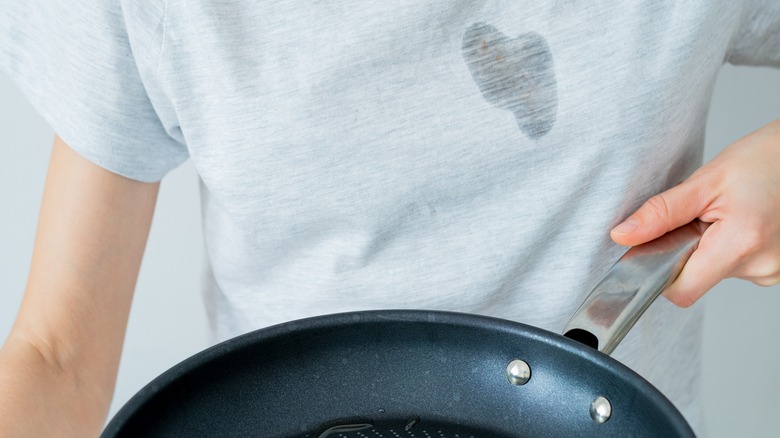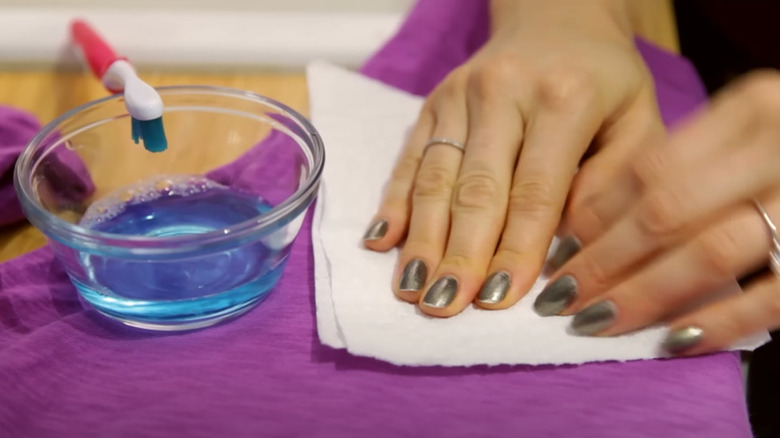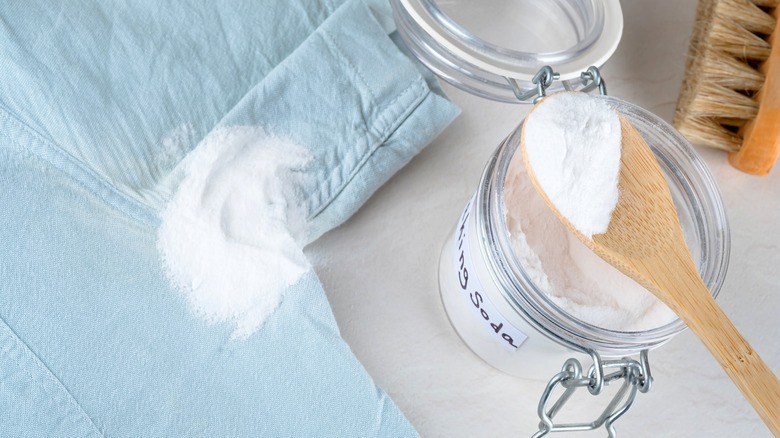Banish Oil Stains From Clothing With A Few Items You Have At Home
We may receive a commission on purchases made from links.
Ah, the drama of oil stains on clothing. Most of us have been there: a hurried lunch break at work with the deceptively tricky-to-consume salad, only to find a droplet of olive oil has sullied your fine shirt. Or perhaps you whipped up a hasty sandwich before heading out, only to notice later that the sly mayonnaise had left its mark on your denim. While these occurrences are as common as the morning sun, getting oil stains out of fabric using water alone doesn't suffice because water and oil simply won't negotiate. But every cloud has a silver lining; in our case, the heroes are regular household items: hydrogen peroxide, baking soda, and a soft-bristled brush.
Hydrogen peroxide (H2O2), the medicine cabinet's resident solution for minor cuts or scrapes, is an oxidizing agent that can break down the oil particles embedded in the clothing fibers. On the other hand, baking soda, the unassuming champ in many kitchen cabinets, absorbs the oily offender. This oil removal hack won't only save your favorite garments but is also surprisingly cost-effective. The required supplies already exist in your home; if not, buying them won't break the bank. For example, 16 ounces of Dealmed Hydrigen Peroxide 3% USP will only cost you $9.99 on Amazon. Not to mention that the process is free from harsh chemicals present in most synthetic stain removal products, positioning you on the eco-conscious front.
Getting out oil stains from clothes with H2O2 and baking soda
When saving your oil-stained clothing, first capitalize on the mild power of warm, soapy water. Begin your assault by carefully blotting the incriminating mark with a dry cloth or paper towel to lift off excess oil. Then, gently work a small amount of dish soap into the spot with a sponge, let it soak your oily enemy, and then rinse it under cold or warm water. If the stain's ghost persists, escalate your offensive with powerful allies — hydrogen peroxide and baking soda. Given H2O2's propensity to irritate the skin and eyes, wearing gloves and staying vigilant against eye contact will tip the scales of safety in your favor.
Next, lay your garment flat, with the stained face upward. Lightly pour hydrogen peroxide onto the stain, enough to moisten without drenching the fabric. Follow up with sprinkling baking over the H2O2-moistened section. Notice the fizziness? That's your cue to grab your soft-bristled toothbrush. Don't scrub too hard, though. Let the mixture sit for 30 to 60 minutes, just enough to reclaim your outfit from the oil stains. Then, send your garment through a regular washing cycle. You might not see the magic of your stain-busting until your fabric is dry. However, don't toss the garment into a dryer because that might make stain remnants even more challenging to remove later. If the stain persists, don't feel discouraged from running another round of paste application and washing.
The caveats for this oil stain removal hack
When you set out to redeem your oil-splattered clothes, remember that hydrogen peroxide's efficacy operates on a sliding scale based on the fabric type and color. The delicate silk and wool fibers are not the best dance partners for this stain removal routine, risking irreversible damage. Next, let's talk about color. Due to its bleaching properties, hydrogen peroxide could wreak havoc on darker shades — yes, that little black dress could now become a bit grey if you're careless. That's why it's high-stakes roulette unless you first sample the mixture on a hidden spot or unused fabric.
While hydrogen peroxide and baking soda band together to ease your oily stain anguish, there are unions you must shun when thinking about enhancing results. Introducing hydrogen peroxide to vinegar forms peracetic acid. This acid's unbridled disinfecting strength is a wolf in sheep's clothing, causing skin and eye irritation as well as respiratory disorders (according to the Environmental Protection Agency).
Similarly, just as some marriages are destined for disaster, the union between H2O2 and bleach has the volatile power to ignite an explosion. Furthermore, the tremendous heat it generates is far from the anticipated tranquility of removing oil stains from clothing. For that reason, let these cleaners march solo. Speaking of alternatives, cornstarch can fill in for baking soda thanks to its oil-soaking acumen. If the H2O2-baking soda pair still doesn't tickle your fancy, white vinegar or lemon juice may fit the bill instead.


